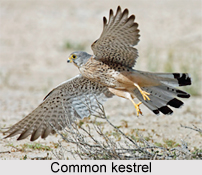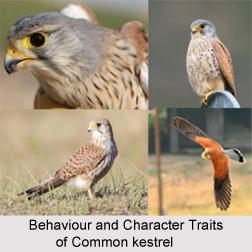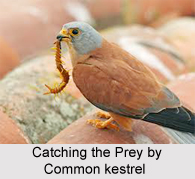 Common Kestrel is an Indian bird, belonging to the family of the Falconidae and bears the scientific name "Falco tinnunculus". Common Kestrel is also known as the European kestrel, Eurasian Kestrel, or Old World Kestrel.
Common Kestrel is an Indian bird, belonging to the family of the Falconidae and bears the scientific name "Falco tinnunculus". Common Kestrel is also known as the European kestrel, Eurasian Kestrel, or Old World Kestrel.
Concentration of Common Kestrel
Common Kestrel occurs over a large range. It is widespread in Europe Asia, and Africa, as well as occasionally reaching the east coast of North America. But although Common kestrel has colonized a few oceanic islands, vagrant individuals are generally rare.
Structure of Common Kestrel
Common Kestrel measures about 32 to 39 cm from head to tail, with a wingspan of 65-82 cm. The females are noticeably larger, with the adult male weighing 136-252 gram, around 155 gram on average; the adult female weighs 154-314 gram, around 184 g on average. They are thus small compared with other birds of prey, but larger than most songbirds. Like the other Falco species, they have long wings as well as a distinctive long tail. The plumage of Common kestrel is mainly light chestnut brown with blackish spots on the upper side and buff with narrow blackish streaks on the underside; the remiges are also blackish. Unlike most raptors, they display sexual colour dimorphism with the male having fewer black spots and streaks, as well as a blue-grey cap and tail. The tail is brown with black bars in females, and has a black tip with a narrow white rim in both sexes. All common kestrels have a prominent black malar stripe like their closest relatives. The cere, feet, and a narrow ring around the eye are bright yellow; the toenails, bill and iris are dark. Juveniles look like adult females, but the underside streaks are wider; the yellow of their bare parts is paler. Hatchlings are covered in white down feathers, changing to a buff-grey second down coat before they grow their first true plumage.
 Climate for Common Kestrel
Climate for Common Kestrel
In the cool-temperate parts of its range, common kestrel migrates south in winter; otherwise it is sedentary, though juveniles may wander around in search for a good place to settle down as they become mature. Common kestrel is a diurnal animal of the lowlands and prefers open habitat such as fields, heaths, shrub land and marshland. It does not require woodland to be present as long as there are alternative perching and nesting sites like rocks or buildings. Common kestrel thrives in treeless steppe where there are abundant herbaceous plants and shrubs to support a population of prey animals. Common kestrel readily adapts to human settlement, as long as sufficient swathes of vegetation are available, and may even be found in wetlands, moor-lands and arid savanna. Common Kestrel is found from the sea to the lower mountain ranges, reaching up to 4,500 metres in the hottest tropical parts of its range but only to about 1,750 m in the subtropical climate of the Himalayan foothills.
Prey for Common Kestrel
Common Kestrel characteristically hovers about 10-20 metres above the ground, searching for prey, either by flying into the wind or by soaring using ridge lift. Like most birds of prey, common kestrels have keen eyesight enabling them to spot small prey from a distance. Once prey is sighted, the bird makes a short, steep dive toward the target. It can often be found hunting along the sides of roads and motorways. This species is able to see near ultraviolet light, allowing the birds to detect the urine trails around rodent burrows as they shine in an ultraviolet colour in the sunlight.
Feeding of Common Kestrel
Common Kestrels eat almost exclusively mouse-sized mammals: typically voles, but also shrews and true mice supply up to three-quarters or more of the biomass most individuals ingest. On oceanic islands, small birds mainly passerine may make up the bulk of its diet while elsewhere birds are only important food during a few weeks each summer when inexperienced fledglings abound. Other suitably sized vertebrates like bats and swifts, frogs and lizards are eaten only on rare occasions. However, kestrels may more often prey on lizards at southern latitudes, in northern latitudes the kestrel is found to more often deliver lizards to their nestlings during midday and also with increasing ambient temperature. Seasonally, arthropods may be a main prey item. Generally, invertebrates like camel spiders and even earthworms, but mainly sizeable insects such as beetles, orthopterans and winged termites are eaten with delight whenever the birds happen upon them.











